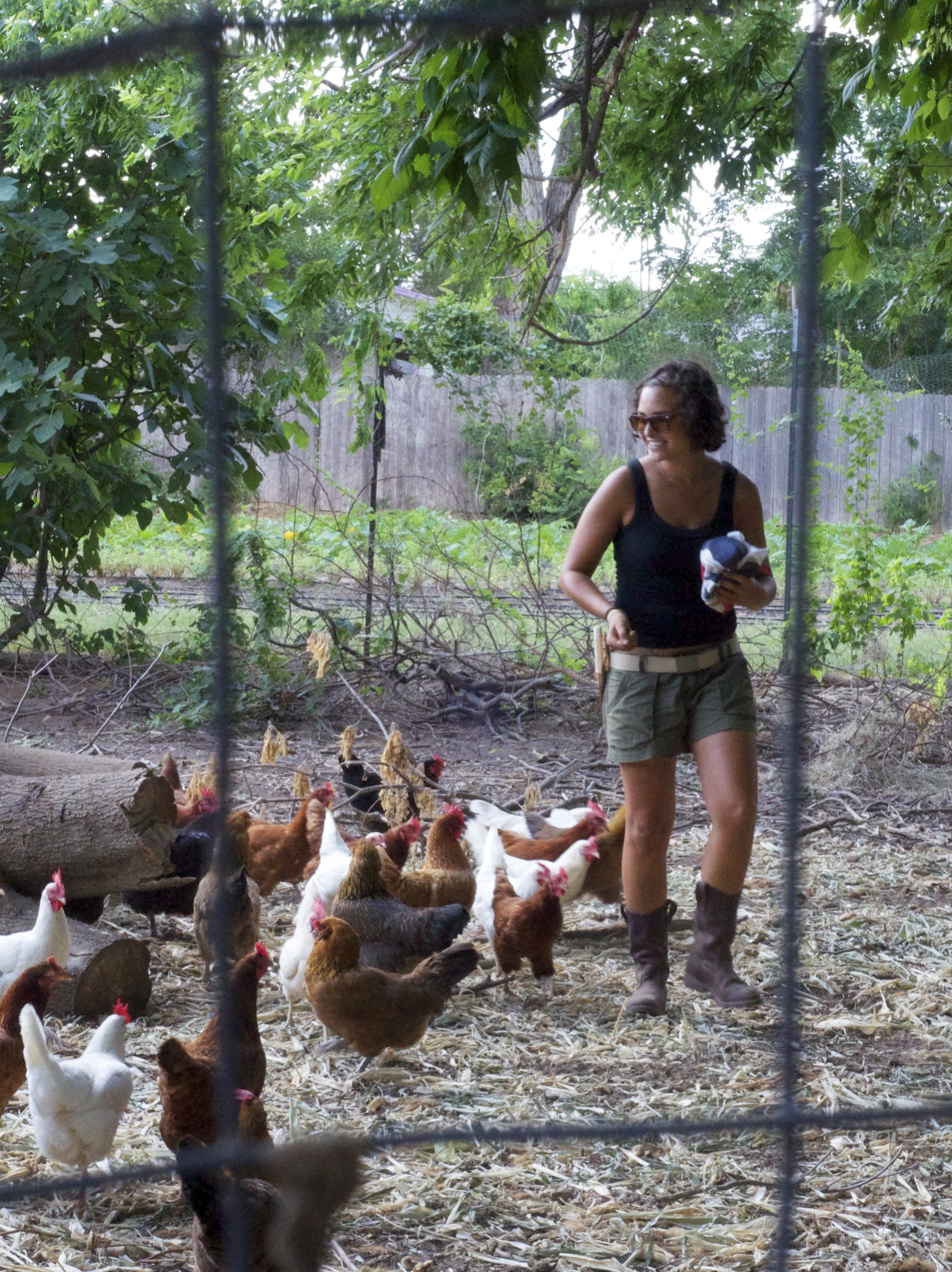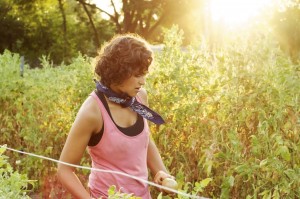6:00 a.m. at Boggy Creek Farm is a magical time. I was at the east Austin farm last Thursday at that early hour and the field in front of the house was as still as a picture. The usually-bustling farm stand lay bare while a full moon hung in the grey sky. Toesy the hen was one of the only creatures stirring before sunrise, her sisters fast asleep in the coop.
By 6:15 a.m. the moment had passed. Roosters crowed, dogs barked, cars honked and Boggy Creek Farm was waking with the dawn. I met farmer Marissa Lankes, 24, on her way into the farmhouse that morning.
“Time to check in with Carol Ann,” she said.
Marissa checks in with Boggy Creek Farm owner Carol Ann Sayle nearly every morning in the farmhouse kitchen. The two banter and discuss the tasks at hand while Marissa fills her water jug and retrieves her Felcos from their hiding place in a drawer near the sink.
“She has to hide those shears here in the house or one of the men will take them,” explained Carol Ann. “They’re safe in that drawer with the sponges– no one else looks there.”
I didn’t ask, but I got the sense that Marissa learned to hide her favorite tool in the kitchen the hard way, and that this was one of many lessons she’d learned from mentor Carol Ann.
Marissa came to work at Boggy Creek several months ago and in her time there she was recently promoted from farm intern to one of two personal assistants who help Carol Anne with the seemingly endless number of tasks on an urban farm.
“The best way to learn how to farm is to work on a farm.” Marissa said. “It’s a double-edged sword, though, since most farmers don’t want to answer all these questions from a 20 year-old kid. Carol Ann isn’t like that, though.”
At Boggy Creek, Carol Ann keeps Marissa busy with a job description that’s as varied as it gets. Marissa helps ready the farm stand for market on Wednesdays and Saturdays, doing everything from making labels for the produce to picking extra cherry tomatoes to pulling earworms from tassels of corn. Four other days a week she tills, harvests and plants the fields; feeds chickens; pulls weeds; manages irrigation and handles myriad other tasks that make up farm life.
When we spoke on Thursday morning the first order of business was to harvest from the field the blush tomatoes and “scalders”– those delicate fruits burned by the sun before they were ready to pick. Marissa plucked tomatoes from the vines for nearly two hours that morning, a light load by her count. While I followed along she gave me a lesson in sustainable farming, tomato picking and the challenges of a beginning farmer in Austin.
Marissa got interested in farming in a roundabout way. She grew up in Detroit and studied fashion design in school, both at Michigan State University and in New York at the Fashion Institute of Technology. There she realized that what drew her most to fashion wasn’t the clothes, it was the self-sufficiency of making ones’ own clothing. Her interest in agriculture developed when she volunteered at the MSU Organic Student Farm, and now the self-reliance of farm life is what keeps her in the field. That, and the food.
In my first tour of the farm I nibbled on four varieties of tomatoes straight off the vine and tasted fresh okra, basil, sorrel and purslane in the field. Marissa had planted most of these delicacies, and she will nurture all of them through Texas’ tough summer. Although she is humble about her cooking abilities (mashed potatoes are her most ambitious dish), Marissa can spot the ripest tomatoes, the most tender okra, and knows exactly when Boggy Creek’s produce will taste best. When we paused from picking tomatoes for a quick breakfast of green zebra heirlooms Thursday, she said that access to safe, healthy food is one of her favorite things about farming.
Another highlight is the variety of jobs she faces day-to-day. For example, after Marissa finished picking tomatoes on Thursday morning she went to cultivate a bed of squash in a field in front of the house. Along the way, she tidied up the tomatoes sitting on the farmhouse porch, visited the chicken coop, weeded a row of cucumbers and fixed several leaks in the nearby irrigation drip tape. (Apparently critters like squirrels love to use drip tape as a water fountain, and their teeth make holes in the hose.)
“There’s not really a routine here. You just see what needs to be done and do it. I like that,” Marissa said. “Sometimes people ask me how we deal with mosquitoes and ants. That’s like asking someone in an office how they cope with the fluorescent lighting.”

That’s not to say farming is without difficulties; there are plenty, Marissa said. One of the alarming facts about farmers is that they make very little money from farming. According to the USDA, in 2011 the average family farm will earn just $11,174 of income from on-farm activities. In fact, the earnings of most family farmers in the U.S. are buoyed by wages from another job, held either by the primary farmer and/or a spouse (source). We didn’t discuss her salary at Boggy Creek, but Marissa expressed realistic expectations for her fortunes as a farmer:
“There’s no money in this,” she said. “No one’s making a living. No one’s getting rich. We don’t have health insurance, but then again, we’re also not getting sick.”
A decidedly more lighthearted challenge Marissa faces in farm life is finding gear that fits. Although there are more than 300,000 women farming in the U.S., clothing companies have been slow to adapt traditional products to this rising demographic. Marissa celebrated her recent birthday with a new pair of Redwing work boots, regarded in the farming world as top of the line.
“These are the most expensive thing I own, besides my car,” she joked. When I asked where she got them, she burst with laughter. “You’ve got to ask that of every woman farmer you meet. It’s impossible to find work boots that fit and I want to know where they shop!”
“I got these at the Redwing store here in Austin,” she continued, “and they had just one pair small enough to fit me– a men’s size five. Still, that’s better than most stores. You go in there and look at the women’s section and they’ll have these hideous gardening shoes and maybe some black chef’s clogs. Not a thing for farmers!”
We both laughed at the irony of Marissa, a former fashion designer, struggling to find work clothes that fit. Still, she said, she wouldn’t trade her work boots for office pumps any day of the week.
Near the end of our visit Marissa opened up about one of the biggest obstacles she sees facing young Austin farmers, the availability of affordable land.
“Our main concern is land. All the time, we’re like, ‘How am I ever going to get land?’ Some people are lucky and they’ll have family land, but otherwise it’s really hard. There’s just not that much capital,” she said.
A quick search of the real estate directory LandandFarm.com reveals that the starting price for a Travis County acreage like Boggy Creek Farm can be in the hundreds of thousands of dollars. Of course, that doesn’t include other farm start-up expenses such as irrigation, supplies, and labor. Marissa said that there are some Farm Service Agency grants available for starting farmers, particularly women, but it’s hard to get excited about taking on the risks that face beginners in their first years.
“Besides, I’ve got the best job in the world right here at Boggy Creek,” she said. “I’m never going to leave.”




